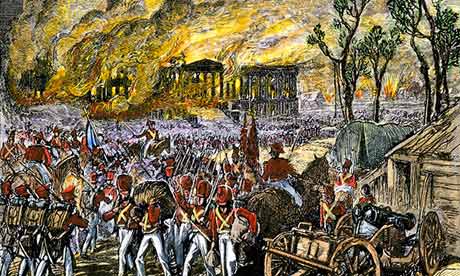 |
| Irish Halloween bonfire - note the wooden pallets, always a favorite with kids at this time of year. {Photo: thanks to Independent.ie} |
It's Halloween season in America and I do mean season. The day I remember as a kid has exploded into a massive season of Halloween-themed celebration.
Where I grew up - north of Albany, NY - Houses are decorated as if it's Christmas and those decorations are up for a month. I guess the cardboard pumpkins on the windows and skeleton on the front door, taped up on the 29th of October, are insufficient to meet the modern American family's need to express its enthusiasm for Halloween.
There are also 'haunted hayrides' and, apparently, every kid has to visit a pumpkin patch these days.
Then there are the stores. They are overflowing with candy, store-bought costumes (adult as well as children sizes), decorations, greeting cards - who sends a Halloween card? - and, of course, pumpkins. Every fast food joint has a pumpkin flavored something or other. Pumpkin coffee? Eh, no thanks.
The thing is, none of this is in the least bit surprising. That people are putting up lights and inflatable vampires is a harmless, if overdone, effort to make things bright and fun for kids. I do wonder if the over-supervised kids of today have anywhere near the fun we had, but these things are hard to gauge.
Slightly more surprising is that it's nearly exactly the same in Ireland. It wasn't always like that. It wasn't even vaguely like that.
When I first arrived in Ireland Halloween was barely a blip. Young kids got dressed up - in whatever their mothers could find in the house - and went to a few doors asking "Any apples or nuts?" That's what they got too. Apples and nuts.
There was no candy. There were no store-bought costumes. There were no decorations. There were no pumpkins.
That's all gone now. In 20 years the American Halloween has become Ireland's Halloween. Kids go door-to-door in store-bought costumes, ringing doorbells on decorated houses, declaring (more than asking) "Trick or treat!" all in the expectation of romping home with bags full of candy. The kids are older too - often 12+. (Substituting candy for apples probably explains that.)
And there are pumpkins. Everywhere. You can get them in the supermarket and your coffee!
 |
| One of the better suburban Halloween scenes. |
Yup, Ireland's Halloween is just about indistinguishable from America's except for one last vestige of the old customs - the bonfire.
The bonfire on Halloween in Ireland is an ancient tradition, but the bonfire isn't so much dying out as being snuffed out. The fire authorities are doing all they can to discourage the continuation of this tradition and I don't really blame them.
Kids gather up all sorts of junk - wooden pallets are a particular favorite - for weeks in advance of Halloween. Old mattresses and even car tires are added to the giant piles. I'm sure that in the past the bonfires were much smaller simply because people threw away so much less, but these days they're huge and dangerous.
On the October 21 Dublin City Council announced that they had seized over 500 tons of pallets, tires and other junk destined for bonfires. That's ten days before Halloween and that's only what they've found. What's not found is probably far greater because kids are on to the adults. They gather and hide this stuff as if it's gold dust, waiting for Halloween night to pile it up and light it on fire.
Of course it isn't just the fire authorities who worry about these bonfires. In my neighborhood parents keep a watchful eye for any hint of a bonfire. None of us wants them, even those who grew up with the tradition. They all seem to accept that today's bonfires are just out of hand. Nobody wants to be downwind of burning tires or mattresses.
I'm with them. I want to see the bonfire disappear. It's against my nature, but I'm with the forces of modernity and keen to see this ancient practice vanish.
** Traditional Irish Halloween foods such as the Barm Brack and Colcannon haven't gone away. Fortunately.

